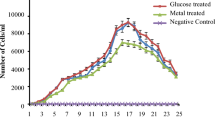Abstract
Industrial effluents are major pollution-causing agents for our environment. Our study focuses on utilizing effluents from different industries for efficient production of Polyhydroxybutyrate (PHB). Presence of PHB was identified by Sudan Black staining method. The PHB production parameters for Pseudomonas aeruginosa MTCC 4673 were studied critically, and it was found that glucose with 8.5 mg/L (0.0550 g PHB/g substrate) PHB concentration yielded the highest among the carbon sources used. Peptone with 8.9 mg/L (0.0524 g PHB/g substrate) of PHB concentration, an incubation period of 48 h and at a pH of 7 yielded the optimum results. These studies were compared with those of Alcaligens latus MTCC 2311. Dairy effluents (DE) and tannery effluents (TE) were considered for the best possible substrate, for the production of PHB in an optimized media. The results indicated that the dairy effluents gave a higher yield of PHB. Amongst various dilution levels studied from 10–100% (v/v), 50% (v/v) concentration of the dairy effluent showed maximum PHB productivity of 0.0582 g PHB/g substrate. A comparison of the chemical oxygen demand (COD) and biological oxygen demand (BOD) from the results, showed a significant removal percentage of 78.97% BOD and 53.482% COD, which highlighted the importance of utilizing effluents for PHB production, in order to reduce the risk of toxic effluent discharge. FT-IR analysis was carried out to confirm the presence of PHB.
Similar content being viewed by others
References
M. Kirithika, K. Rajarathinam and S. Venkatesan, Dev. Microbiol. Mol. Biol., 2, 1 (2009).
R. Leaversuch, Mod. Plastic, 8, 52 (1987).
P. A. Holmes, Phys. Technol., 16, 32 (1985).
S. Y. Lee, Biotechnol. Bioeng., 49, 1 (1996).
S.Y. Lee, K. M. Lee, H. N. Chang and A. Steinbuchel, Biotechnol. Bioeng., 44, 1337 (1994).
A. Arun, A. Murrugappan, D. David Ravindran, V. Veeramanikandan and Shanmuga Balaji, Afr. J. Biotechnol., 5, 1524 (2006).
P. H. Yu, H. Chua, A. L. Huang and K. P. Ho, Appl. Biochem. Biotechnol., 78, 445 (1999).
R. Z. Sayeed and N. S. Ganguurde, Ind. J. Exp. Biol., 5, 68 (2010).
E. Grothe, M.M. Young and Y. Chisti, Enz. Microbiol., Technol., 25, 132 (1999).
E. A. Dawes and P. J. Senio, Adv. Microb. Pbys., 10, 266 (1973).
B. S. Kim, S. C. Lee, S.Y. Lee, H. N. Chang, Y. K. Chang and S. I. Woo, Biotechnol. Bioeng., 43, 892 (1994).
S.W. Kim, P. Kim, H. S. Lee and J. H. Kim, Biotechnol. Lett., 18, 25 (1996).
H. Preusting, R. van Houten, A. Hoefs, E. K. van Langenberghe, O. Favre-Bulle and B. Witholt, Biotechnol. Bioeng., 41, 550 (1993).
O. Hrabak, FEMS Microbiol. Rev., 103, 251 (1992).
K. Sujatha, A. Mahalakshmi and Shenbagarathai, Ind. J. Biotechnol., 4, 216 (2005).
K.W. Nickerson, W. J. Zarnick and V. C. Kramer, FEMS Microbiol. Lett., 12, 327 (1981).
Y. Wakisaka, E. Masaki and Y. Nishimoto, Appl. Environ. Microbiol., 43, 1473 (1982).
A. J. Anderson, G.W. Haywood and E. A. Dawes, Int. J. Biol. Macromol., 12, 102 (1990).
A. Azhar, A.M. El-sayed, Abdel Hafez, Hemmat M. Abdelhady and T. A. Khodair, Aust. J. Basic Appl. Sci., 3, 617 (2009).
J. Choi and S.Y. Lee, Appl. Microbiol. Biotechnol., 51, 13 (1999).
S. R. Pandian, V. Deepak, K. Kalishwaralal, N. Rameshkumar, M. Jeyaraj and S. Gurunathan, Bioresour. Technol., 101, 705 (2009).
E. A. Dawes and P. J. Senior, Adv. Microbiol. Phys., 10, 135 (1973).
Z.T. Dobroth, H. Shengjun, E. R. Coats and A.G. McDonald, Bioresour. Technol., 102, 3352 (2011).
S. Sangyoka, N. Poomipuk and A. Reungsang, Sains Malaysiana, 41, 1211 (2012).
T. Rawate and S. Mavinkurve, Curr. Sci., 83, 562 (2002).
B. Senthilkumar and G. Prabakaran, Ind. J. Biotechnol., 76–79 (2006).
Author information
Authors and Affiliations
Corresponding author
Rights and permissions
About this article
Cite this article
Muralidharan, R., Sindhuja, P.B., Sudalai, A. et al. Polyhydroxybutyrate production accompanied by the effective reduction of chemical oxygen demand (COD) and biological oxygen demand (BOD) from industrial effluent. Korean J. Chem. Eng. 30, 2191–2196 (2013). https://doi.org/10.1007/s11814-013-0169-6
Received:
Accepted:
Published:
Issue Date:
DOI: https://doi.org/10.1007/s11814-013-0169-6




